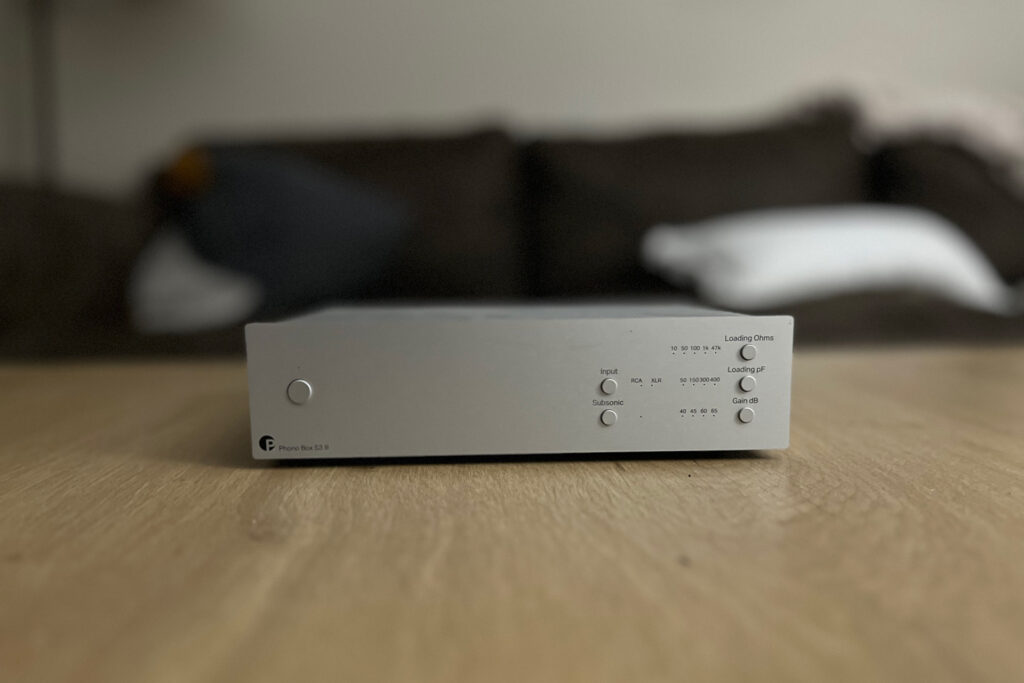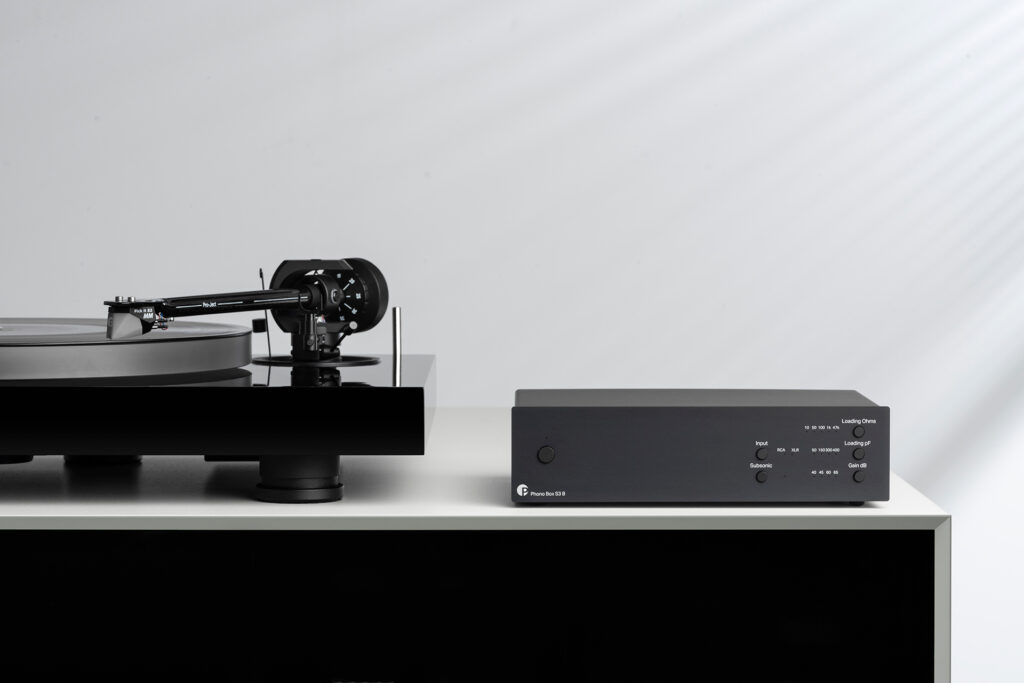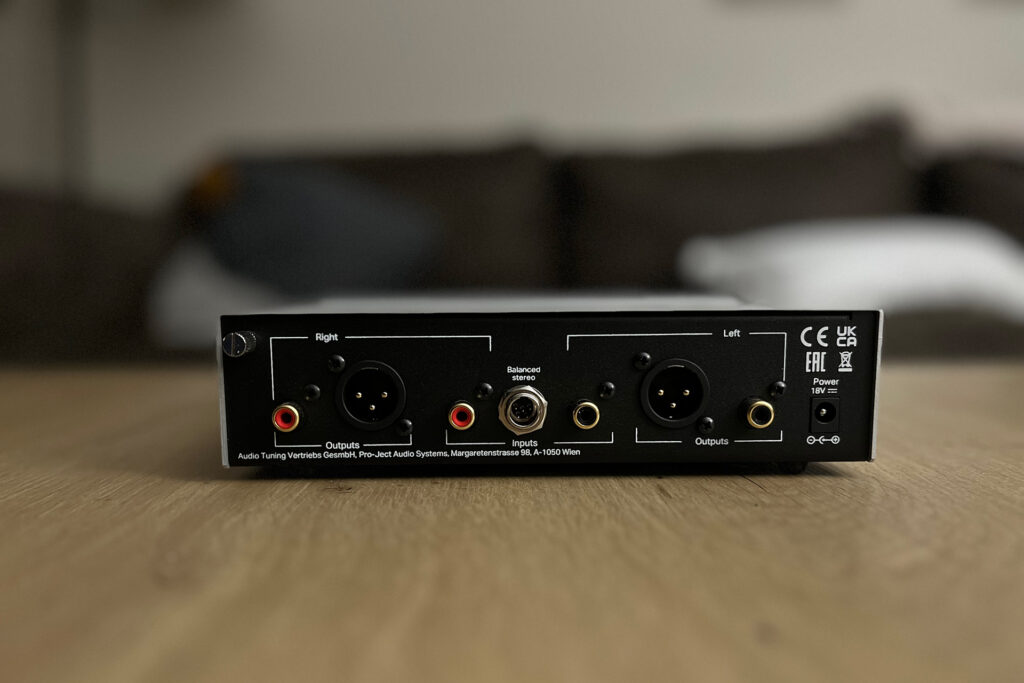In recent years, Pro-Ject have established themselves as one of the biggest players in the affordable vinyl space for audiophiles. Not only do they make high-quality turntables at varying reasonable price points, but they also have a range of phono preamplifiers (aka: phonostages) that roughly matcha the same price points as their turntables. The Pro-Ject Phono Box S3 B phonostage fits in around the midpoint of Pro-Ject’s line of phonostages, with Phono Box MM representing the bottom and the Phono Box RS2 at the top. This affordable phonostage features the aforementioned balanced input and output (to make “balanced” operation work the unit converts the signal via a mini XLR 5 pin input to single ended for RIAA equalization then back to balanced), as well as unbalanced options which need no conversion to get the RIAA EQ. It also has selectable input impedance, input capacitance, selectable gain, a toggle between the balanced and unbalanced inputs, and a subsonic filter. You can also buy this phonostage in either black or silver. All of this represents a very respectable package at its price. Let’s take a closer look and see if it is a piece you should consider adding into your signal chain.

What Makes the Pro-Ject Phono Box S3 B Phonostage So Special?
- The Pro-Ject Phono Box S3 B phonostage offers a balanced connection although not balanced performance without conversion from balanced to unbalanced and back again. Nearly all turntables are unbalanced in their operation although Pro-Ject is changing that trend with more modern audiophile turntables. XLR connectors are more robust and have less noise but in this case, the component isn’t balanced which is important to note but by no means a ding against a very affordable and high performance phonostage.
- Having a moving coil option allows you the option to upgrade your cartridge without needing a new phonostage. Having an upgrade path for your gear is always great to have, no matter the piece of audiophile gear.
- Being able to configure the input impedance and input capacitance ensures you get the right sound from your cartridge. This can be done right from the front panel versus other comparable phonostages with have rear or even internal “dip switches” thus making adjustments much easier. The standard phonostage that you find built into your preamplifier, integrated amplifier or turntable passively equalizes the sound and needs to also normalize the impedance and capacitance that is coming in from your cartridge. This can lead to your vinyl not sounding as good as it can, but when you can configure these settings, you can ensure that you are getting the sound that the manufacturer intended for your turntable.
- There is a subsonic filter included in the Phono Box S3B phonostage. A filter might not be the reason you buy a phonostage, but having one is nice if your vinyl collection has some flaws to it, as the filter will help smooth some of those flaws from wear and tear to the vinyl you might hear when you are listening.
Why Should You Care About the Pro-Ject Phono Box S3 B Phonostage?
If you’re someone who is looking to have their vinyl sound the best it can at a reasonable price, you should be in the market for a phonostage that features options like configurable input impedance, input capacitance, and gain settings. It is the best way to ensure that you are getting the most out of your turntable’s sonic performance, even if you don’t have billionaire-class dollars to spend. Pro-Ject has added in balanced input and output, which really separates it from the rest of the market in this price category. Most of Pro-Ject’s competitors don’t start to offer balanced output connections in their phonostages until you’re spending nearly double the cost of the Phono Box S3 B, and balanced input is really a feature that you are mostly only finding on Pro-Ject turntables or uber-expensive units in the $5,000 to $10,000-plus range right now, but that could change in the future. That’s a lot of performance for not a lot of money, and we love that kind of value.

Some Things You Might Not Like About the Pro-Ject Phono Box S3 B Phonostage
- Finding the right cable to go from Pro-Ject’s turntables to Phono Box S3 B can be a little bit of a challenge. Pro-Ject had provided me with one of their balanced cables as I was reviewing this phonostage close to when I was reviewing one of their X line of turntables. But when I went from the XA B turntable (read my review) I was reviewing to my Pro-Ject X1 B turntable (read my other review here) in my reference system, the input on the X1 B wasn’t the right one. For most audiophiles at this price point, RCA connectors are the way to go with turntables/vinyl, but balanced operation is often a better connection and a quieter one, thus I made sure I had the right cables. In this case, I got some new ones from Wireworld from their Series 10. Affordable. No “house sound,” just good connection, which is what I like with cables.
- Like many other audiophile phonostages, the Pro-Ject Phono Box S3 B doesn’t have a fully functional volume control. You can manually adjust the gain, but you cannot truly adjust the volume, so you won’t be able to go directly from the phonostage to an amplifier. You will want a more traditional preamplifier to be positioned in your system somewhere in between. It seems that this simplistic audiophile system configuration works better with DACs, and digital sources with streamers and DACs. In the analog world, you really need a traditional stereo preamp of sorts to control your volume. To be clear, you can adjust the gain of this phonostage, which is a big deal, but you wouldn’t use it for every album that you play as you would a traditional audiophile preamp.
Listening to the Pro-Ject Phono Box S3 B Phonostage …
I ran this phonostage with my Pro-Ject X1 B turntable, which uses a Sumiko Rainier cartridge. I ran the Pro-Ject Phono Box S3 B into my Anthem STR preamplifier to my Anthem MCA 225 Gen 2 amplifier, with the sound coming out of my Paradigm Premier 700F floorstanding speakers. I connected the phonostage to the turntable and to the Anthem STR preamplifier using Wireworld Stratus cables (balanced XLR to the preamplifier, and unbalanced with ground to the turntable).
I started with a Vampire Weekend track titled “I Think Ur A Contra” from their 2010 album “Contra.” This is a slower track from this New York quartet, which is typically known for their fusion of pop with more international beats. This track sounded beautiful played through the Pro-Ject Phono Box S3 B phonostage. All the notes had lots of room to breathe, and all of the details of the notes were able to flourish. The soundstage was intact, and it was easy to imagine the music being played right in front of you. On other comparably-priced phonostages, you might not get the same level of detail that you get from in the Pro-Ject. I am reviewing a handful in this category, which was helpful in the comparison.
Whenever I am reviewing something with vinyl, I love digging up Yes’ “Roundabout” from their 1971 Fragile album. The band at this stage was made up of Jon Anderson, Steve Howe, Chris Squire, Rick Wakeman (his first with the band), and Bill Bruford. “Roundabout” is the opening track of the album, eight-and-a-half-minutes that feature a little bit of everything. There is an opening Spanish-style acoustic guitar track, to one of Squire’s best basslines, to synthesizer solos and nearly everything in between. The Pro-Ject Phono Box S3 phonostage did a fine job holding this track together as it shifted back and forth between various time signatures. It was easy to pick out the different instruments throughout the track, and there wasn’t any noticeable coloration that was added to the sound. A very enjoyable listen indeed.
The last track I used to test the Pro-Ject Phono Box S3 B phonostage was “Thunder Road” from Bruce Springsteen’s 1975 iconic album Born to Run. This album is a remarkable production that maintains its exceptional sound and production quality over five decades. From the outset of this hit song, the piano sounded remarkably realistic, as if the musicians were performing in front of you. The imaging was attention-grabbing with the Pro-Ject in the loop in my system. As the track built in intensity, it accurately separated Springsteen’s vocals and the E Street Band’s instruments, placing them across the soundstage. The Pro-Ject Phono Box S3 B does a great job of not adding any color to the sounds, and this track, even though I have heard it countless number of times, felt like it had some new life.
Will the Pro-Ject Phono Box S3 B Phonostage Hold Its Value?
There are many factors that will determine how well a phonostage like the Pro-Ject Phono Box S3B will hold its value over time. Will people continue to purchase vinyl? I bet they will even with the higher cost of a new album today. A small audiophile component like this is a not-subtle upgrade that costs close to nothing. Then again at these low retail prices – this product falls into the who cares category as you can give it away or just recycle it when you are done as it is easy to get that small amount of investment back out as audiophile value.
What is the Competition for the Pro-Ject Phono Box S3 B Phonostage?
The iFi Zen Phono 3 ($250) is about half the cost of the Pro-Ject Phono Box S3 B. Keep in mind this phonostage is fully unbalanced, so if you are looking for a balanced connection option, this won’t be for you. This offering from iFi however does have configurable gain for both moving magnet and moving coil cartridges, four input impedance settings, and a subsonic filter.
The Schiit Skoll F ($399) is a very direct competitor to the Phono Box S3 B, and at a very similar price. The Skoll F has balanced and unbalanced connection inputs and outputs, selectable gain settings, resistive loading and capacitive loading, and two filters. This Phonostage handles moving magnet and coil input options as well.
The Mobile Fidelity UltraPhono ($499) is also worth a look in this price range. It isn’t balanced, but it can be customized with the impedance and gain, and has 12 DIP switches that allow you to match the settings of your cartridge. Along with a subsonic filter, Mobile Fidelity also lets you switch into a mono mode for any of your vinyl that may have been recorded in mono. On top of that, this phonostage also functions as a headphone amplifier if you prefer to listen to your vinyl through headphones instead of speakers

Final Thoughts on the Pro-ject Phono Box S3 B Phonostage …
The Pro-Ject Phono Box S3 B hits all the marks that you should be looking for in a phonostage. It handles moving magnet and moving coils, which provide an upgrade path for any audiophile, and it allows you to configure the phonostage to match the settings of your cartridge, which is essential, especially when you are dealing with moving coil cartridges. These are essentially table stakes for this type of product at this price point.
Balanced turntables are not incredibly common these days, but even without the ability for the Phono Box S3 B being able to receive a balanced input, you are still getting a solid value, with balanced output, and the phonostage reproducing your vinyl sound without any additional color but with vastly upgraded sound over most basic turntables. This piece of audiophile equipment should be something you try out if you are in the market for an affordable phonostage, as you won’t be disappointed with the quality of the product in any way.



